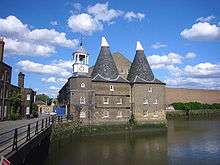Three Mills

The Three Mills are former working mills on the River Lea in the East End of London, one of London’s oldest extant industrial centres. The largest and most powerful of the four remaining tidal mills is possibly the largest tidal mill in the world. It is mainly accessed by a bridge over the Limehouse Cut and River Lea.
The River Lea Tidal Mill Trust Ltd owns the House Mill and the Miller's House buildings, which are used for educational projects and as conference spaces. The Lower Lea Project is also based at Three Mills in The Miller's House. The Prescott Channel, a former flood relief channel, to the east, creates Three Mills Island, and the mills share this with the 3 Mills Studios, a 10 acre film and TV studio, which makes a large number of major films and television programmes.
History
It is thought that there were eight or possibly nine mills on the River Lea in Stratford at the time of the Domesday Book (though this number may refer to the number of pairs of millstones rather than buildings). These would therefore have been the earliest recorded examples of a tidal mill system.
Stratford Langthorne Abbey, founded in 1135, acquired the three mills some time in the 12th or 13th centuries, and the area became known as Three Mills. By the time Henry VIII dissolved the abbey in the 1530s, the mills were grinding flour for the bakers of Stratford-atte-Bow, who were celebrated for the quality of their bread and who supplied the huge City of London market. In 1588, one of the mills was described as a "gunpowder mill". During the 16th century the three mills were reduced to two (which today are the House Mill and the Clock Mill). In the 17th century the mills were used to grind grain, which was then used to distil alcohol; the mills became a major supplier to the alcohol trade and gin palaces of London.
The House Mill was built in 1776 (and after a fire destroyed it, quickly rebuilt) by Daniel Bisson. It is a grade I listed building. [1] The Clock Mill was rebuilt by Philip Metcalfe between 1815 and 1817 incorporating the old clock, and an older bell. There was also a windmill which survived until about 1840. The House Mill continued to operate until 1940 and the Clock Mill until 1952.
In 1878 there were seven waterwheels at Three Mills.[2] Most of them were around 20 ft in diameter and 3 ft in width, but one was 8 ft in width. There were four in the House Mill and three in the Clock Mill. They drove fourteen pairs of millstones and produced a total of 150 HP (112KW). The average output of the House Mill was about 2 tons of maize and 5 tons of barley per tide rising to 10 and 14 tons respectively on spring tides. The average weekly throughput of the two mills was 125 tons per week.
Ownership changed relatively frequently during the 17th to the late 19th centuries, until 1872 when it was purchased by gin distillers J&W Nicholson & Co of Clerkenwell. Initially producing Lamplighter Gin on site, the company eventually moved production of all of their brands to the site. Distilling ceased in 1941 during the rationing shortages of World War II. The Nicholson family, headed by Sir Richard Nicholson, sold the business to the Distillers Company. Three Mills sustained severe air-raid damage during the Second World War. The Miller's House was destroyed in 1941 and rebuilt in 1995 with a modern interior and rear part, but retaining the original facade. Three Mills was used for bottling and warehousing by Bass Charrington and Hedges & Butler.
The House Mill remains the largest tidal mill in the world, although the water wheels are not in operation. The building is owned by The River Lea Tidal Mill Trust Ltd and is open to visitors on Sunday afternoons during the summer. It is one of only four grade I listed buildings in the London Borough of Newham.
The creation of the Three Mills Lock on the Prescott Channel and the Three Mills Wall River Weir, for the 2012 Summer Olympics construction work, has created a head of water behind the mill. This may mean that it can be operated again, but it has partially removed the tidal benefits of the site.
References
- ↑ Historic England. "Tide Mill (Grade I) (1080970)". National Heritage List for England. Retrieved 16 September 2015.
- ↑ Martin Watts (1998). The House Mill, Bromley by Bow, London. River Lee Tidal Mill Trust Ltd.
External links
- 3 Mills Studios – official website
- Engineering Timelines – Three Mills (1776, 1817)
- Chain Reaction Theatre Company – Educational theatre champions based at Three Mills Studios
- The River Lea Tidal Mill Trust Ltd, also known as House Mill
Coordinates: 51°31′38.29″N 00°00′27.25″W / 51.5273028°N 0.0075694°W